Evaluation of Fir Forest Die-Back and Regeneration After a Severe Bark Beetle Disturbance Using UAV-Based Remote Sensing
Highlights
- By 2025, the treeline had retreated 385 m downslope and 186 m in elevation by a severe double-pest infestation, with extreme weather conditions further exacerbating the retreat.
- UAV imagery was employed to monitor the increase of young trees from 60 in 2019 to 119 in 2025.
- Long-term UAV-based monitoring provides reliable high resolution quantitative data on die-back and regeneration dynamics in mountainous areas with limited access.
- These insights support forest recovery assessment and inform long-term management strategies after bark beetle outbreaks.
Abstract
1. Introduction
2. Materials and Methods
2.1. Study Area
2.2. UAV Image Collection and Pre-Processing
2.3. Young Tree Definition
2.4. Annotations
2.5. Field Survey
2.6. Data Analysis
3. Results
3.1. Treeline Dynamics
3.2. Die-Back
3.3. Regeneration
4. Discussion
4.1. Image Quality, Detection Limitations, and Interpretation Uncertainty
4.2. Disturbance Dynamics: Die-Back, and Tree Fall Patterns
4.3. Natural Regeneration, Sasa Interactions, and Biotic Protection
4.4. Forest Landscape Transformation and Socioecological Implications
4.5. Comparative Perspectives on Bark Beetle Impacts and Forest Recovery
4.6. Implications for Forest Management and Remote Sensing Integration
5. Conclusions
Author Contributions
Funding
Data Availability Statement
Acknowledgments
Conflicts of Interest
Abbreviations
| ST | Standing Trees |
| DFT | Dead Fallen Trees |
| LFT | Living Fallen Trees |
| VF | Visible Fallen Trees |
| NF | Newly Detected Fallen Tree |
| INF | Invisible Fallen Trees |
| FSDT | Fallen Standing Dead Trees |
| ND | Newly Detected Standing Dead Trees |
| IND | Invisible Standing Dead Trees |
| VD | Visible Standing Dead Trees |
References
- Bogdziewicz, M.; Hacket-Pain, A.; Kelly, D.; Thomas, P.A.; Lageard, J.; Tanentzap, A.J. Climate warming causes mast seeding to break down by reducing sensitivity to weather cues. Glob. Change Biol. 2021, 27, 1952–1961. [Google Scholar] [CrossRef]
- König, L.; Mohren, G.; Schelhaas, M.J.; Bugmann, H.; Nabuurs, G.J. Tree regeneration in models of forest dynamics—Suitability to assess climate change impacts on European forests. For. Ecol. Manag. 2022, 520, 120390. [Google Scholar] [CrossRef]
- Díaz-Yáñez, O.; Käber, Y.; Anders, T.; Bohn, F.; Braziunas, K.H.; Brǔna, J.; Fischer, R.; Fischer, S.M.; Hetzer, J.; Hickler, T.; et al. Tree regeneration in models of forest dynamics: A key priority for further research. Ecosphere 2024, 15, e4807. [Google Scholar] [CrossRef]
- Berdanier, A.B.; Clark, J.S. Divergent reproductive allocation trade-offs with canopy exposure across tree species in temperate forests. Ecosphere 2016, 7, e01313. [Google Scholar] [CrossRef]
- Käber, Y.; Meyer, P.; Stillhard, J.; De Lombaerde, E.; Zell, J.; Stadelmann, G.; Bugmann, H.; Bigler, C. Tree recruitment is determined by stand structure and shade tolerance with uncertain role of climate and water relations. Ecol. Evol. 2021, 11, 12182–12203. [Google Scholar] [CrossRef] [PubMed]
- Fernandez-Carrillo, A.; Patočka, Z.; Dobrovolnỳ, L.; Franco-Nieto, A.; Revilla-Romero, B. Monitoring bark beetle forest damage in Central Europe. A remote sensing approach validated with field data. Remote Sens. 2020, 12, 3634. [Google Scholar] [CrossRef]
- Jayathunga, S.; Pearse, G.D.; Watt, M.S. Unsupervised methodology for large-scale tree seedling mapping in diverse forestry settings using UAV-based RGB imagery. Remote Sens. 2023, 15, 5276. [Google Scholar] [CrossRef]
- Pommerening, A.; Szmyt, J.; Duchiron, M.S. Revisiting silvicultural systems: Towards a systematic and generic design of tree regeneration methods. Trees For. People 2024, 17, 100597. [Google Scholar] [CrossRef]
- Witzmann, S.; Gollob, C.; Kraßnitzer, R.; Ritter, T.; Tockner, A.; Moik, L.; Sarkleti, V.; Ofner-Graff, T.; Schume, H.; Nothdurft, A. Quantification of Forest Regeneration on Forest Inventory Sample Plots Using Point Clouds from Personal Laser Scanning. Remote Sens. 2025, 17, 269. [Google Scholar] [CrossRef]
- Genç, Ç.Ö.; Altunel, A.O. Monitoring the operational changes in surface reflectances after logging, based on popular indices over Sentinel-2, Landsat-8, and ASTER imageries. Environ. Monit. Assess. 2025, 197, 120. [Google Scholar] [CrossRef]
- El Badri, A.; El Qryefy, M. Assessment of post-fire regeneration in the Mesguina forest (Morocco) using remote sensing and geographic information systems. Ecol. Eng. Environ. Technol. 2025. [Google Scholar]
- Wu, D.; Lu, D.; Zhu, C.; Ge, X.; Lin, L.; Gao, T.; Zhu, J. Long-term gap regeneration processes in a primary temperate forest of Northeast China: Evidence from integrated multi-temporal remote sensing and field surveys. For. Ecol. Manag. 2025, 593, 122902. [Google Scholar] [CrossRef]
- Torresan, C.; Berton, A.; Carotenuto, F.; Di Gennaro, S.F.; Gioli, B.; Matese, A.; Miglietta, F.; Vagnoli, C.; Zaldei, A.; Wallace, L. Forestry applications of UAVs in Europe: A review. Int. J. Remote Sens. 2017, 38, 2427–2447. [Google Scholar] [CrossRef]
- Guimarães, N.; Pádua, L.; Marques, P.; Silva, N.; Peres, E.; Sousa, J.J. Forestry remote sensing from unmanned aerial vehicles: A review focusing on the data, processing and potentialities. Remote Sens. 2020, 12, 1046. [Google Scholar] [CrossRef]
- Fassnacht, F.E.; White, J.C.; Wulder, M.A.; Næsset, E. Remote sensing in forestry: Current challenges, considerations and directions. For. Int. J. For. Res. 2024, 97, 11–37. [Google Scholar] [CrossRef]
- Vindiš, P.; Kelc, D.; Berk, P. Detection of bark beetle infestations by drone and image analysis in spruce forests. Šumarski List 2025, 149, 127–135. [Google Scholar] [CrossRef]
- Bozzini, A.; Huo, L.; Brugnaro, S.; Morgante, G.; Persson, H.J.; Finozzi, V.; Battisti, A.; Faccoli, M. Multispectral drone images for the early detection of bark beetle infestations: Assessment over large forest areas in the Italian South-Eastern Alps. Front. For. Glob. Chang. 2025, 8, 1532954. [Google Scholar] [CrossRef]
- Huo, L.; Matsiakh, I.; Bohlin, J.; Cleary, M. Estimation of Tree Vitality Reduced by Pine Needle Disease Using Multispectral Drone Images. Remote Sens. 2025, 17, 271. [Google Scholar] [CrossRef]
- Leidemer, T.; Gonroudobou, O.B.H.; Nguyen, H.T.; Ferracini, C.; Burkhard, B.; Diez, Y.; Lopez Caceres, M.L. Classifying the degree of bark beetle-induced damage on fir (Abies mariesii) forests, from UAV-acquired RGB images. Computation 2022, 10, 63. [Google Scholar] [CrossRef]
- Tran, T.C.N.; Lopez Caceres, M.L.; Riera, S.G.i.; Conciatori, M.; Kuwabara, Y.; Tsou, C.Y.; Diez, Y. Using UAV RGB Images for Assessing Tree Species Diversity in Elevation Gradient of Zao Mountains. Remote Sens. 2024, 16, 3831. [Google Scholar] [CrossRef]
- Mierkalne, K.S.; Bergmanis, I. Evaluating forest regeneration success after selective logging using unmanned aerial vehicles and remote sensing. In Proceedings of the 20th International Scientific Conference Students on Their Way to Science (Undergraduate, Graduate, Post-Graduate Students) Collection of Abstracts, Jelgava, Latvia, 25 April 2025; p. 75. [Google Scholar]
- Conciatori, M.; Tran, N.T.C.; Diez, Y.; Valletta, A.; Segalini, A.; Lopez Caceres, M.L. Plant species classification and biodiversity estimation from UAV images with deep learning. Remote Sens. 2024, 16, 3654. [Google Scholar] [CrossRef]
- Hao, Z.; Yao, S.; Post, C.J.; Mikhailova, E.A.; Lin, L. Comparative performance of convolutional neural networks for detecting and mapping a young Casuarina equisetifolia L. forest from unmanned aerial vehicle (UAV) imagery. New For. 2025, 56, 40. [Google Scholar] [CrossRef]
- Ecke, S.; Stehr, F.; Dempewolf, J.; Frey, J.; Klemmt, H.J.; Seifert, T.; Tiede, D. Species-specific machine learning models for UAV-based forest health monitoring: Revealing the importance of the BNDVI. Int. J. Appl. Earth Obs. Geoinf. 2024, 135, 104257. [Google Scholar] [CrossRef]
- Leidemer, T.; Lopez Caceres, M.L.; Diez, Y.; Ferracini, C.; Tsou, C.Y.; Katahira, M. Evaluation of Temporal Trends in Forest Health Status Using Precise Remote Sensing. Drones 2025, 9, 337. [Google Scholar] [CrossRef]
- Velasco Pereira, E.A.; Navarro-Cerrillo, R.M. Post-fire regeneration dynamics of heterogeneous Mediterranean ecosystems using Landsat and ALS data. Sci. Total Environ. 2025, 1001, 180435. [Google Scholar] [CrossRef] [PubMed]
- Pinto, R.C.; Gorgens, E.B.; de Almeida, D.R.A.; Peña-Claros, M.; Schwartz, G.; Vidal, E. Natural regeneration responses of tree species at the end of the first timber harvesting cycle in the Eastern Amazon. For. Ecol. Manag. 2025, 594, 122947. [Google Scholar] [CrossRef]
- Fuqua, J.K. Postfire Conifer Regeneration: Optimal Microsite Factors and the Potential for UAS in Forest Monitoring. Master’s Thesis, Oregon State University, Corvallis, OR, USA, 2025. [Google Scholar]
- So, K.; Chau, J.; Rudd, S.; Robinson, D.T.; Chen, J.; Cyr, D.; Gonsamo, A. Direct Estimation of Forest Aboveground Biomass from UAV LiDAR and RGB Observations in Forest Stands with Various Tree Densities. Remote Sens. 2025, 17, 2091. [Google Scholar] [CrossRef]
- Chiba, S.; Kawatsu, S.; Hayashida, M. Large-area mapping of the mass mortality and subsequent regeneration of Abies mariesii forests in the Zao Mountains in Northern Japan. J. Jpn. For. Soc. 2020, 102, 108–114. [Google Scholar] [CrossRef]
- Kirkpatrick, J.; Bridle, K. The role of fallen logs in the regeneration of tree species in Tasmanian mixed forest. For. Ecol. Manag. 1999, 114, 265–277. [Google Scholar] [CrossRef]
- Jezek, J.; Bezdek, M.; Kolek, J.; Hrivnak, M.; Zamecnik, J. Effect of coarse woody debris on seedling establishment in boreal forest gaps. For. Ecol. Manag. 2004, 203, 179–187. [Google Scholar]
- Iijima, H.; Nakashizuka, T. Effects of coarse woody debris on seedling growth of Abies mariesii in subalpine forests. J. For. Res. 2010, 15, 123–130. [Google Scholar]
- Seidl, R.; Potterf, M.; Müller, J.; Turner, M.G.; Rammer, W. Patterns of early post-disturbance reorganization in Central European forests. Proc. R. Soc. B Biol. Sci. 2024, 291, 20240625. [Google Scholar] [CrossRef]
- Zeppenfeld, T.; Svoboda, M.; DeRose, R.J.; Heurich, M.; Müller, J.; Čížková, P.; Starý, M.; Bače, R.; Donato, D.C. Response of mountain Picea abies forests to stand-replacing bark beetle outbreaks: Neighbourhood effects lead to self-replacement. J. Appl. Ecol. 2015, 52, 1402–1411. [Google Scholar] [CrossRef]
- Davis, T.S.; Rhoades, P.R.; Mann, A.J.; Griswold, T. Bark beetle outbreak enhances biodiversity and foraging habitat of native bees in alpine landscapes of the southern Rocky Mountains. Sci. Rep. 2020, 10, 16400. [Google Scholar] [CrossRef] [PubMed]
- Körner, C. Mountain biodiversity, climate change and elevation shift of alpine treelines. Ecol. Stud. 2004, 167, 1–21. [Google Scholar]
- Hansson, A.; Dargusch, P.; Shulmeister, J. A review of modern treeline migration, the factors controlling it and the implications for carbon storage. J. Mt. Sci. 2021, 18, 291–306. [Google Scholar] [CrossRef]
- Harsch, M.A.; Hulme, P.E.; McGlone, M.S.; Duncan, R.P. Are treelines advancing? A global meta-analysis of treeline response to climate warming. Ecography 2009, 32, 1–13. [Google Scholar] [CrossRef]
- Garbarino, M.; Morresi, D.; Anselmetto, N.; Weisberg, P.J. Treeline dynamics under natural and anthropogenic influences: A global perspective. Glob. Ecol. Biogeogr. 2023, 32, 1975–1989. [Google Scholar] [CrossRef]
- Podolskiy, E.A.; Nygaard, B.E.K.; Nishimura, K.; Makkonen, L.; Lozowski, E.P. Study of unusual atmospheric icing at Mount Zao, Japan, using the Weather Research and Forecasting model. J. Geophys. Res. Atmos. 2012, 117, D12. [Google Scholar] [CrossRef]
- Takahashi, K.; Uemura, S.; Suzuki, J.-I.; Hara, T. Effects of understory dwarf bamboo on soil water and the growth of overstory trees in a dense secondary *Betula ermanii* forest, northern Japan. Ecol. Res. 2003, 18, 767–774. [Google Scholar] [CrossRef]
- Tripathi, S.K.; Sumida, A.; Shibata, H.; Uemura, S.; Ono, K.; Hara, T. Growth and substrate quality of fine root and soil nitrogen availability in a young *Betula ermanii* forest of northern Japan: Effects of the removal of understory dwarf bamboo (*Sasa kurilensis*). For. Ecol. Manag. 2005, 212, 278–290. [Google Scholar] [CrossRef]
- Abe, M.; Miguchi, H.; Honda, A.; Makita, A.; Nakashizuka, T. Short-term changes affecting regeneration of *Fagus crenata* after the simultaneous death of *Sasa kurilensis*. J. Veg. Sci. 2005, 16, 49–56. [Google Scholar] [CrossRef]
- Yano, K. Ice monster (Jyuhyo) in Mt. Zao. J. Snow Eng. Jpn. 1989, 5, 23–32. [Google Scholar] [CrossRef]
- Miyagi Prefectural Government. Tourism Statistics Overview. 2023. Available online: https://www.pref.miyagi.jp/soshiki/kankou/statistical.html (accessed on 28 September 2025). (In Japanese).
- Yano, K. Meteorological observations at Zao, Yamagata prefecture (1). Snow Life Tohoku 1994, 9, 75. [Google Scholar]
- Japan Meteorological Agency (JMA). Monthly Mean Air Temperature, Sendai (Station ID: 47590). 2025. Available online: https://www.jma.go.jp/jma/indexe.html (accessed on 28 September 2025).
- Moritake, K.; Cabezas, M.; Nhung, T.T.C.; Caceres, M.L.L.; Diez, Y. Sub-alpine shrub classification using UAV images: Performance of human observers vs DL classifiers. Ecol. Informatics 2024, 80, 1–16. [Google Scholar] [CrossRef]
- Sakai, A.; Matsui, K.; Kabeya, D.; Sakai, S. Altitudinal Variation in Lifetime Growth Trajectory and Reproductive Schedule of a Sub-Alpine Conifer Abies Mariesii. Ph.D. Thesis, Tohoku University, Sendai, Japan, 2003. [Google Scholar]
- Dandois, J.P.; Ellis, E.C. High spatial resolution three-dimensional mapping of vegetation spectral dynamics using computer vision. Remote Sens. Environ. 2013, 136, 259–276. [Google Scholar] [CrossRef]
- Wallace, L.; Lucieer, A.; Watson, C. Assessing the feasibility of UAV-based LiDAR for high resolution forest change detection. Int. Arch. Photogramm. Remote Sens. Spat. Inf. Sci. 2012, 39, 499–504. [Google Scholar] [CrossRef]
- Bréda, N.J. Ground-based measurements of leaf area index: A review of methods, instruments and current controversies. J. Exp. Bot. 2003, 54, 2403–2417. [Google Scholar] [CrossRef]
- SnowJapan. Zao Onsen Ski Area Snow Data. 2025. Available online: https://www.snowjapan.com/japan-ski-resorts/yamagata/yamagata/zao-onsen/snow-data?utm_source=chatgpt.com (accessed on 9 October 2025).
- Japan Meteorological Agency (JMA). Daily Meteorological Data for Yamagata City, Japan, 2025. Data Downloaded from JMA Website (J), Daily Records from December 2018 to February 2025. Available online: https://www.data.jma.go.jp/stats/etrn/view/daily_s1.php?prec_no=35&block_no=47588&year=2018&month=12&day=&view=p1 (accessed on 9 October 2025).
- Senf, C.; Pflugmacher, D.; Zhiqiang, Y.; Sebald, J.; Knorn, J.; Neumann, M.; Hostert, P.; Seidl, R. Canopy mortality has doubled in Europe’s temperate forests over the last three decades. Nat. Commun. 2018, 9, 4978. [Google Scholar] [CrossRef]
- Delavarpour, N.; Koparan, C.; Nowatzki, J.; Bajwa, S.; Sun, X. A technical study on UAV characteristics for precision agriculture applications and associated practical challenges. Remote Sens. 2021, 13, 1204. [Google Scholar] [CrossRef]
- Whitmore, T.C. A review of some aspects of tropical rain forest seedling ecology with suggestions for further enquiry. Man Biosph. Ser. 1996, 17, 3–40. [Google Scholar]
- Franklin, J.F.; Spies, T.A.; Van Pelt, R.; Carey, A.B.; Thornburgh, D.A.; Berg, D.R.; Lindenmayer, D.B.; Harmon, M.E.; Keeton, W.S.; Shaw, D.C.; et al. Disturbances and structural development of natural forest ecosystems with silvicultural implications, using Douglas-fir forests as an example. For. Ecol. Manag. 2002, 155, 399–423. [Google Scholar] [CrossRef]
- Nakashizuka, T. Regeneration of beech (Fagus crenata) after the simultaneous death of undergrowing dwarf bamboo (Sasa kurilensis). Ecol. Res. 1988, 3, 21–35. [Google Scholar] [CrossRef]
- Yamamoto, S.I. Gap characteristics and gap regeneration in subalpine old-growth coniferous forests, central Japan. Ecol. Res. 1995, 10, 31–39. [Google Scholar] [CrossRef]
- Tohoku Forest Management Bureau (MAFF). Status and Response to Abies mariesii Dieback in the Zao Region (Yamagata Prefecture Side); Official Report. Ministry of Agriculture, Forestry and Fisheries: Japan, 2024. Available online: https://yamagatayama.com/jyuhyo/wp-content/uploads/2024/01/%E8%94%B5%E7%8E%8B%E5%9C%B0%E5%9F%9F%EF%BC%88%E5%B1%B1%E5%BD%A2%E7%9C%8C%E5%81%B4%EF%BC%89%E3%81%AB%E3%81%8A%E3%81%91%E3%82%8B%E3%82%AA%E3%82%AA%E3%82%B7%E3%83%A9%E3%83%93%E3%82%BD%E3%81%AE%E6%9E%AF%E6%90%8D%E5%AE%9F%E6%85%8B%E3%81%A8%E5%AF%BE%E5%BF%9C%E7%8A%B6%E6%B3%81%EF%BC%88%E6%9D%B1%E5%8C%97%E6%A3%AE%E6%9E%97%E7%AE%A1%E7%90%86%E5%B1%80%EF%BC%89.pdf (accessed on 9 October 2025).
- Barbosa, P.; Hines, J.; Kaplan, I.; Martinson, H.; Szczepaniec, A.; Szendrei, Z. Associational resistance and associational susceptibility: Having right or wrong neighbors. Annu. Rev. Ecol. Evol. Syst. 2009, 40, 1–20. [Google Scholar] [CrossRef]
- Jensen, A.M.; Götmark, F.; Löf, M. Shrubs protect oak seedlings against ungulate browsing in temperate broadleaved forests of conservation interest: A field experiment. For. Ecol. Manag. 2012, 266, 187–193. [Google Scholar] [CrossRef]
- Deng, J.; Fang, S.; Fang, X.; Jin, Y.; Kuang, Y.; Lin, F.; Liu, J.; Ma, J.; Nie, Y.; Ouyang, S.; et al. Forest understory vegetation study: Current status and future trends. For. Res. 2023, 3, 6. [Google Scholar] [CrossRef]
- Narukawa, Y.; Yamamoto, S. Effects of dwarf bamboo (Sasa sp.) and forest floor microsites on conifer seedling recruitment in a subalpine forest, Japan. For. Ecol. Manag. 2002, 163, 61–70. [Google Scholar] [CrossRef]
- Walck, J.L.; Hidayati, S.N.; Dixon, K.W.; Thompson, K.; Poschlod, P. Climate change and plant regeneration from seed. Glob. Change Biol. 2011, 17, 2145–2161. [Google Scholar] [CrossRef]
- Johnson, A.C.; Yeakley, J.A. Microsites and climate zones: Seedling regeneration in the alpine treeline ecotone worldwide. Forests 2019, 10, 864. [Google Scholar] [CrossRef]
- Seki, T.; Ohta, S.; Fujiwara, T.; Nakashizuka, T. Growth allocation between height and stem diameter in nonsuppressed reproducing Abies mariesii trees. Plant Species Biol. 2013, 28, 146–155. [Google Scholar] [CrossRef]
- Daskalakou, E.N.; Koutsovoulou, K.; Ioannidis, K.; Koulelis, P.P.; Ganatsas, P.; Thanos, C.A. Masting and regeneration dynamics of Abies cephalonica, the Greek endemic silver fir. Seed Sci. Res. 2019, 29, 227–237. [Google Scholar] [CrossRef]
- Kautz, M. On correcting the time-lag bias in aerial-surveyed bark beetle infestation data. For. Ecol. Manag. 2014, 322, 78–88. [Google Scholar] [CrossRef]
- Trautwein, J.F.; Rohde, L.R.; Militz, H.; Brischke, C. Outer appearance of bark-beetle-infested stands of Norway spruce after different standing storage durations: A case study in the Harz Mountains, Germany. Eur. J. For. Res. 2025, 36, 1–17. [Google Scholar] [CrossRef]
- Schiller, A.; Udelhoven, J.; Götte, P.; Förster, F.M.; Köhler, I.; Thiel, C. Early detection of bark beetle infestations in Central Europe using deep learning-based reconstructions of irregular Sentinel-2 time series. Remote Sens. Environ. 2025, 321, 114226. [Google Scholar] [CrossRef]
- Rodman, K.C.; Andrus, R.A.; Carlson, A.R.; Carter, T.A.; Chapman, T.B.; Coop, J.D.; Fornwalt, P.J.; Gill, N.S.; Harvey, B.J.; Hoffman, A.E.; et al. Rocky Mountain forests are poised to recover following bark beetle outbreaks but with altered composition. J. Ecol. 2022, 110, 1851–1865. [Google Scholar] [CrossRef]
- FOREST EUROPE. Managing Bark Beetle Outbreaks in the 21st Century: Policy Brief. 2023. Available online: https://foresteurope.org/wp-content/uploads/2023/07/Policy-brief-Managing-bark-beetle-outbreaks-in-the-21st-century.pdf (accessed on 9 October 2025).
- Holl, K.D.; Aide, T.M. When and where to actively restore ecosystems? For. Ecol. Manag. 2011, 261, 1558–1563. [Google Scholar] [CrossRef]
- Chazdon, R.L. Beyond deforestation: Restoring forests and ecosystem services on degraded lands. Science 2008, 320, 1458–1460. [Google Scholar] [CrossRef]
- Kudo, G.; Kawai, Y.; Amagai, Y.; Winkler, D.E. Degradation and recovery of an alpine plant community: Experimental removal of an encroaching dwarf bamboo. Alp. Bot. 2017, 127, 75–83. [Google Scholar] [CrossRef]
- Goodbody, T.R.; Coops, N.C.; Senf, C.; Seidl, R. Airborne laser scanning to optimize the sampling efficiency of a forest management inventory in south-eastern Germany. Ecol. Indic. 2023, 157, 111281. [Google Scholar] [CrossRef]

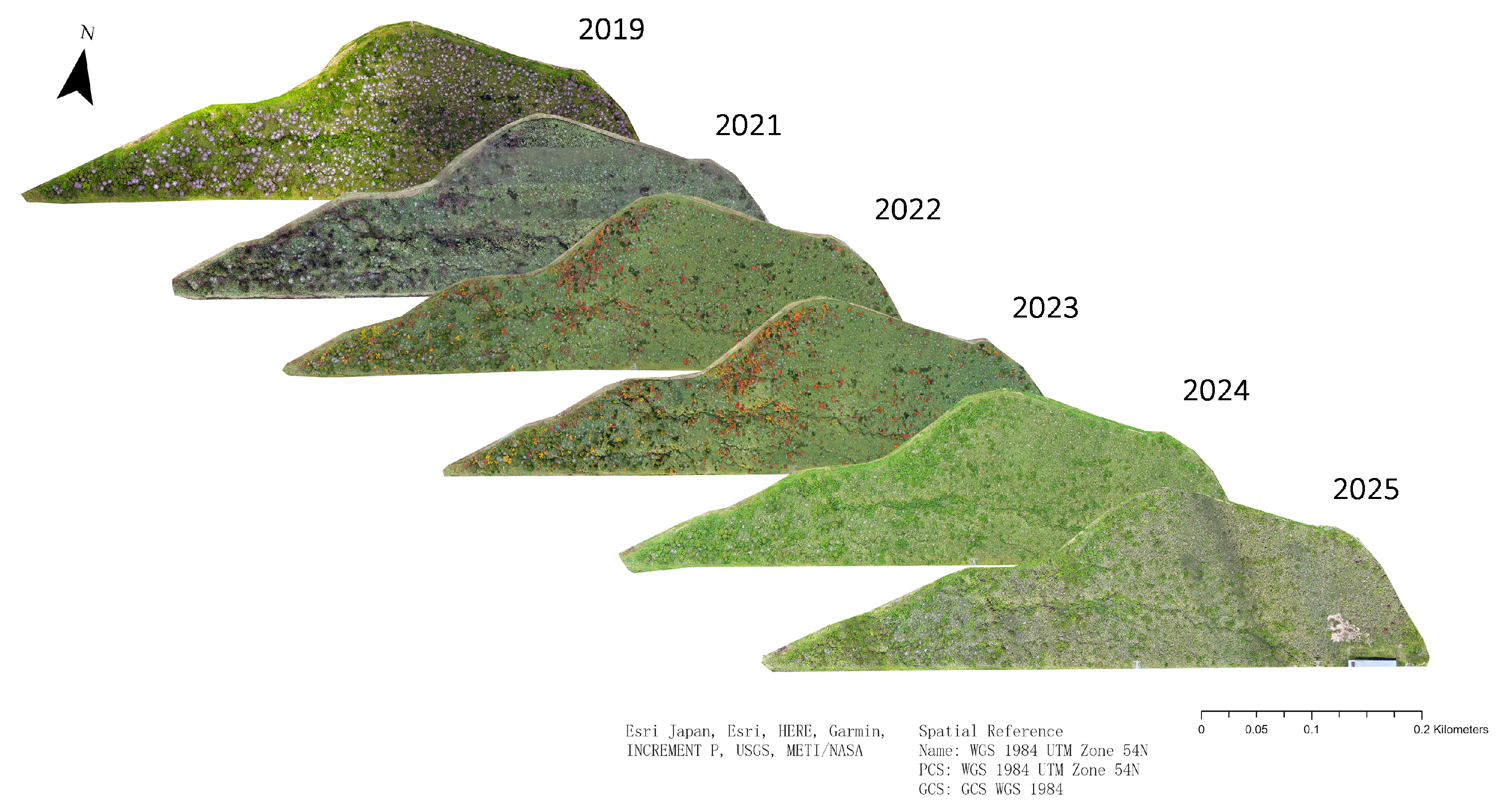

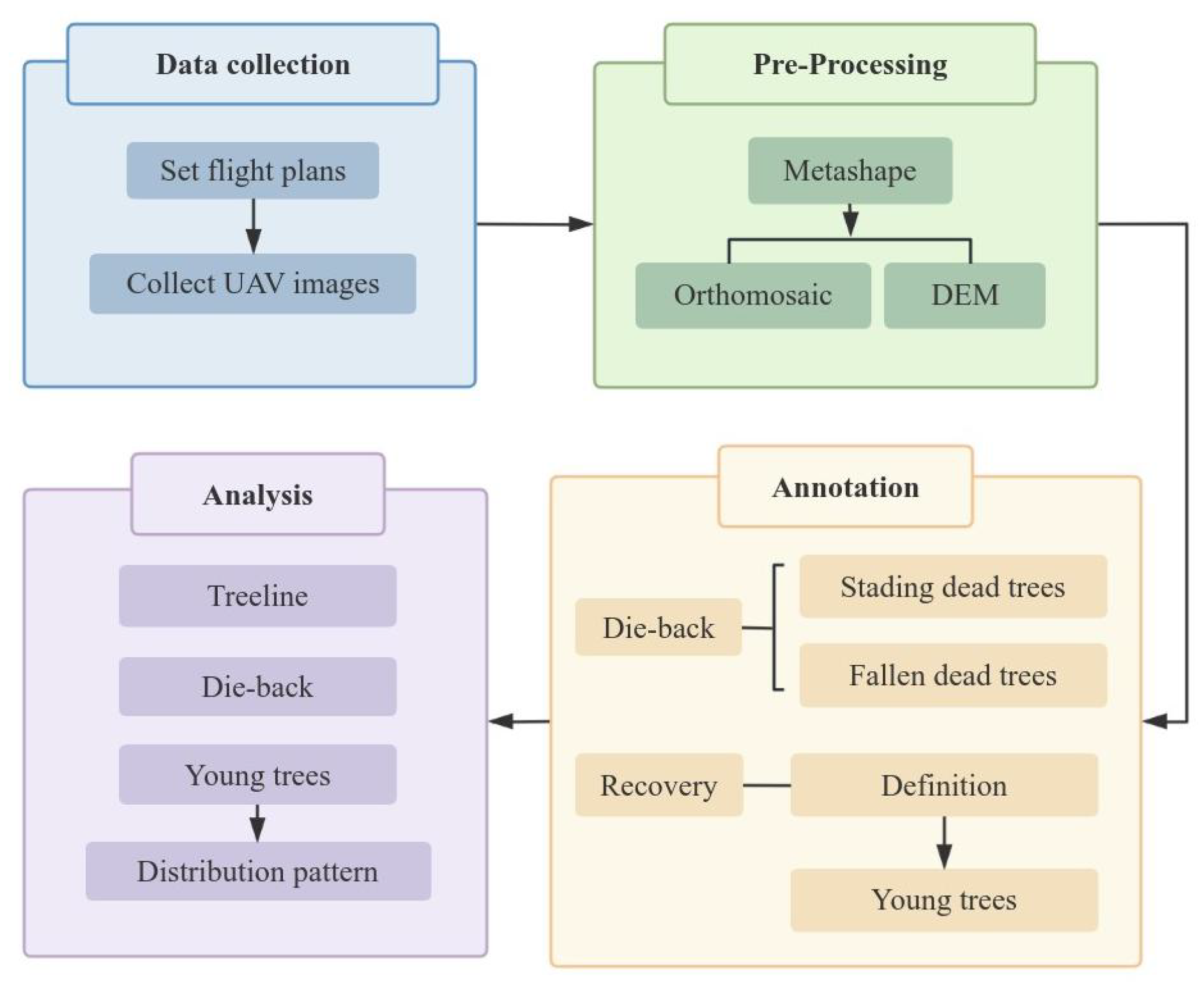
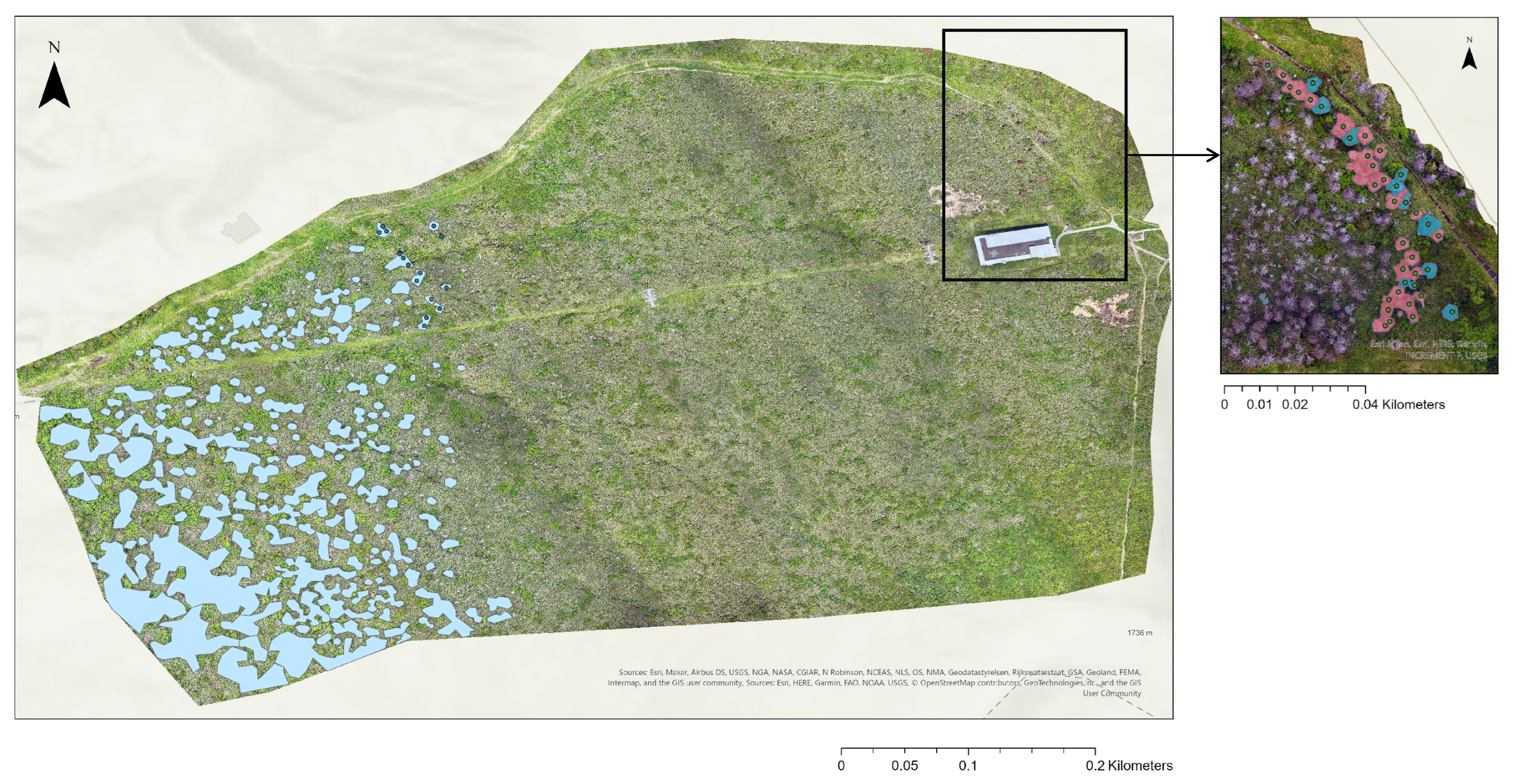
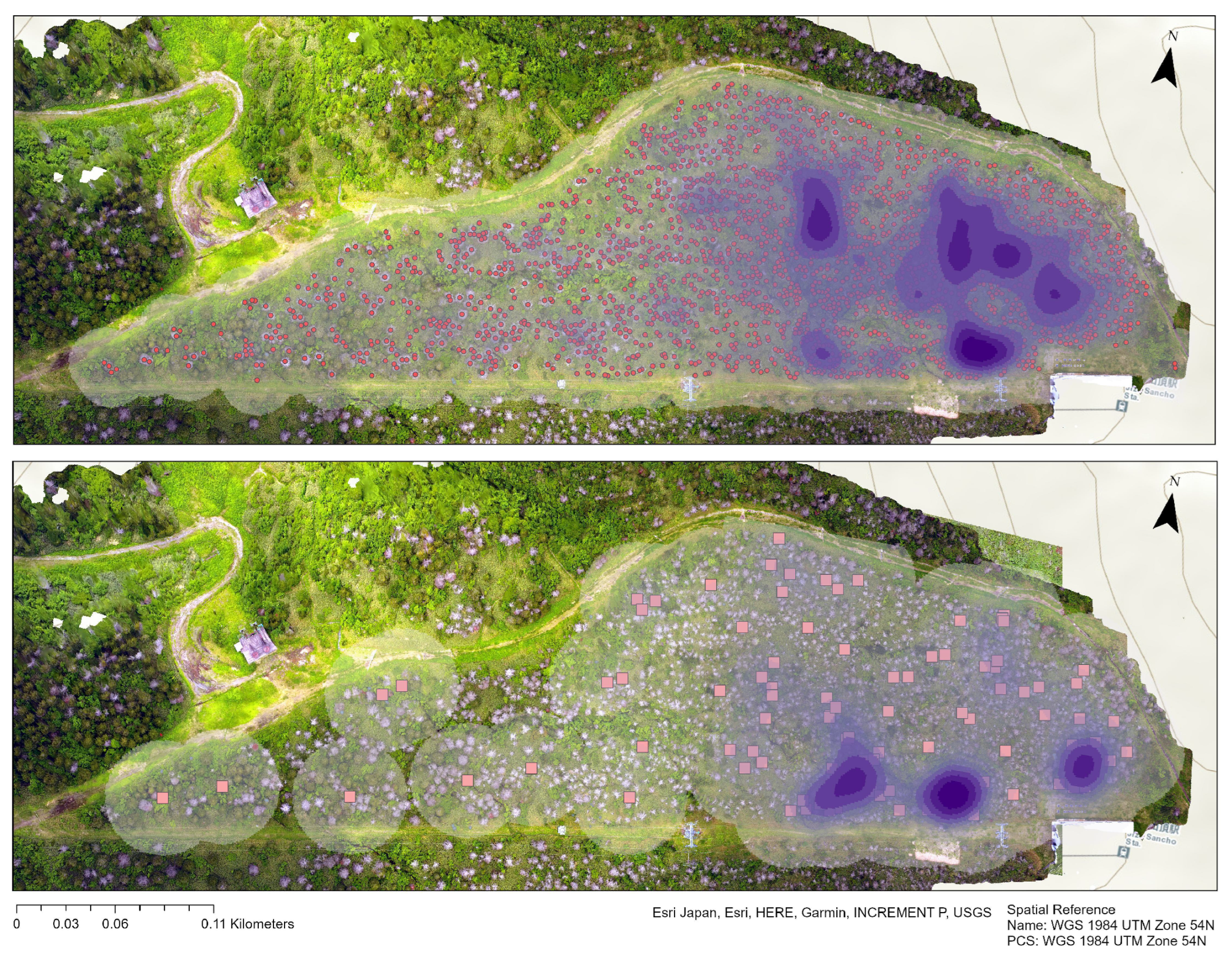

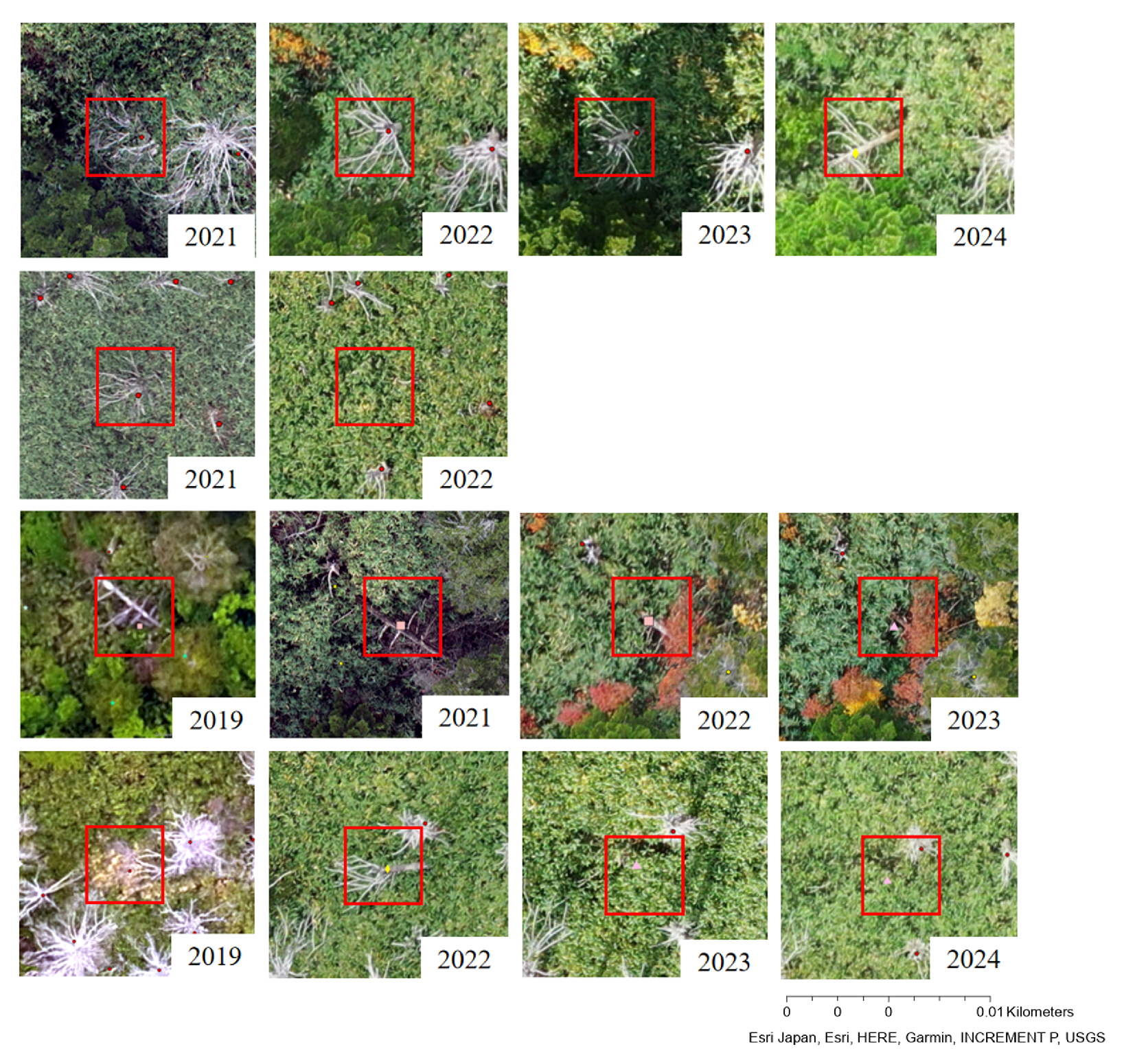


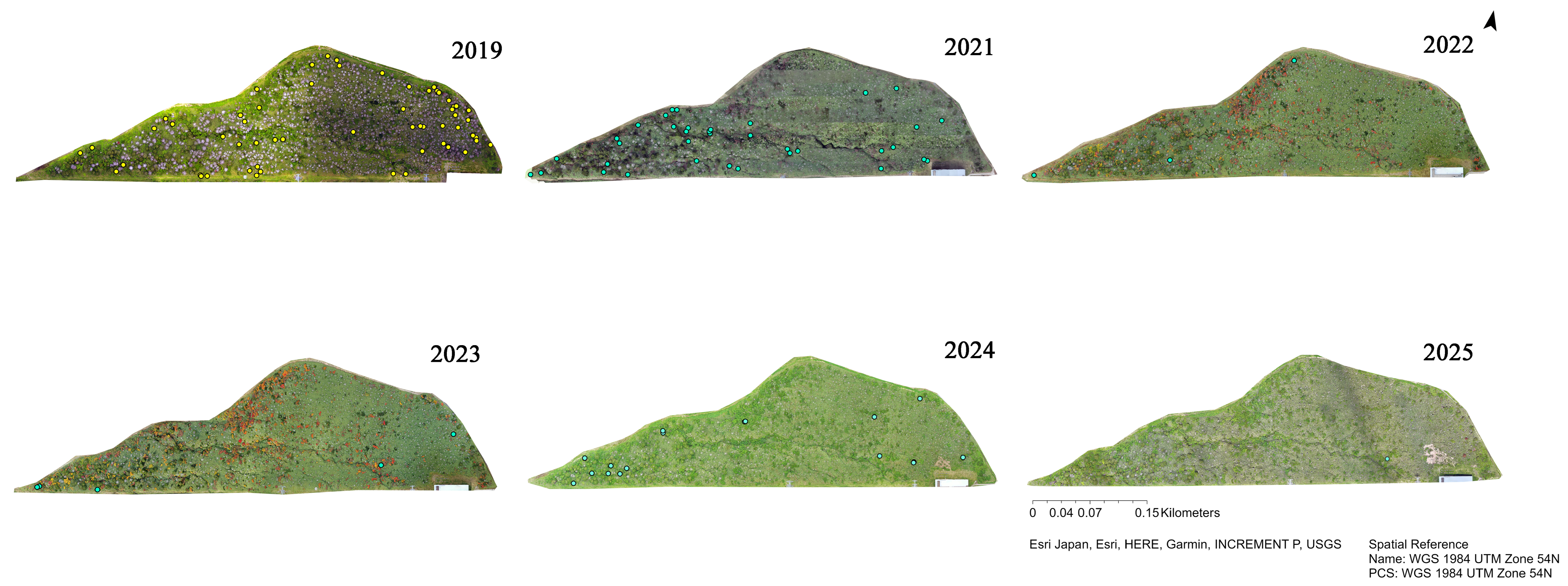
| Year | Visible Standing Dead Trees | Visible Fallen Trees | Total Number | Change Rate (%) |
|---|---|---|---|---|
| 2019 | 2787 | 112 | 2899 | — |
| 2021 | 2779 | 55 | 2834 | −2.24 |
| 2022 | 2669 | 89 | 2758 | −2.68 |
| 2023 | 2553 | 80 | 2633 | −4.53 |
| 2024 | 2495 | 102 | 2597 | −1.37 |
| 2025 | 2224 1 | 346 1 | 2570 | −1.04 |
| 2019 | 2021 | 2022 | 2023 | 2024 | 2025 | |
|---|---|---|---|---|---|---|
| ST | 3023 | 3012 | 2877 | 2758 | 2699 | 2472 1 |
| DFT | 0 | 11 | 124 | 116 | 58 | 220 |
| LFT | 0 | 0 | 11 | 3 | 1 | 7 |
| CUT | 51 |
| VF | NF | INF | FSDT | CUT | ND | IND | VD | |
|---|---|---|---|---|---|---|---|---|
| 2019 | 112 | 0 | 0 | 0 | 0 | 0 | 0 | 2787 |
| 2021 | 55 | 6 | 63 | 6 | 0 | 3 | 5 | 2779 |
| 2022 | 89 | 64 | 30 | 53 | 0 | 14 | 71 | 2669 |
| 2023 | 80 | 26 | 35 | 23 | 0 | 0 | 93 | 2553 |
| 2024 | 102 | 31 | 9 | 30 | 0 | 0 | 28 | 2495 |
| 2025 | 346 1 | 212 | 19 | 256 | 51 | 0 | 15 | 2224 |
| Year | Total Number | Dead | Newly Observed | Damaged | Fallen | Invisible |
|---|---|---|---|---|---|---|
| 2019 | 60 | 0 | 0 | 0 | 0 | 0 |
| 2021 | 96 | 3 | 36 | 1 | 0 | 0 |
| 2022 | 99 | 0 | 3 | 0 | 1 | 0 |
| 2023 | 101 | 0 | 5 | 1 | 0 | 3 |
| 2024 | 118 | 0 | 17 | 1 | 0 | 0 |
| 2025 | 119 | 1 | 1 | 1 | 0 | 0 |
Disclaimer/Publisher’s Note: The statements, opinions and data contained in all publications are solely those of the individual author(s) and contributor(s) and not of MDPI and/or the editor(s). MDPI and/or the editor(s) disclaim responsibility for any injury to people or property resulting from any ideas, methods, instructions or products referred to in the content. |
© 2025 by the authors. Licensee MDPI, Basel, Switzerland. This article is an open access article distributed under the terms and conditions of the Creative Commons Attribution (CC BY) license (https://creativecommons.org/licenses/by/4.0/).
Share and Cite
Wu, P.; Lopez Caceres, M.L.; Tien, N.L.; Shimizu, H.; Galindo, V.V.; Zhang, H.; Tsou, C.-Y. Evaluation of Fir Forest Die-Back and Regeneration After a Severe Bark Beetle Disturbance Using UAV-Based Remote Sensing. Remote Sens. 2025, 17, 3782. https://doi.org/10.3390/rs17233782
Wu P, Lopez Caceres ML, Tien NL, Shimizu H, Galindo VV, Zhang H, Tsou C-Y. Evaluation of Fir Forest Die-Back and Regeneration After a Severe Bark Beetle Disturbance Using UAV-Based Remote Sensing. Remote Sensing. 2025; 17(23):3782. https://doi.org/10.3390/rs17233782
Chicago/Turabian StyleWu, Peiheng, Maximo Larry Lopez Caceres, Nguyen Le Tien, Hisaya Shimizu, Victoria Vera Galindo, Haizhong Zhang, and Ching-Ying Tsou. 2025. "Evaluation of Fir Forest Die-Back and Regeneration After a Severe Bark Beetle Disturbance Using UAV-Based Remote Sensing" Remote Sensing 17, no. 23: 3782. https://doi.org/10.3390/rs17233782
APA StyleWu, P., Lopez Caceres, M. L., Tien, N. L., Shimizu, H., Galindo, V. V., Zhang, H., & Tsou, C.-Y. (2025). Evaluation of Fir Forest Die-Back and Regeneration After a Severe Bark Beetle Disturbance Using UAV-Based Remote Sensing. Remote Sensing, 17(23), 3782. https://doi.org/10.3390/rs17233782






